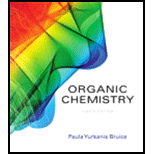
Concept explainers
(a)
Interpretation:
The identical, enantiomer, diastereomer or constitutional isomers for the given compound has to be identified from the given pairs of each compound.
Concept introduction:
Stereoisomers are isomers which have different spatial arrangement in spite of same bond connectivity. Stereoisomers are due to the presence of stereocenter.
The interchanging the solid-hatched wedge line of two groups of asymmetric centers will give different configuration.
Diastereomers are stereoisomers which are neither mirror images nor identical. If two stereoisomers are not enantiomers, then they are Diastereomers.
The pair of Enantiomers non-superimposable mirror images of each other.
The interchanging of two groups for two times on a asymmetric center will produce identical structures.
(b)
Interpretation:
The identical, enantiomer, diastereomer or constitutional isomers for the given compound has to be identified from the given pairs of each compound.
Concept introduction:
Stereoisomers are isomers which have different spatial arrangement in spite of same bond connectivity. Stereoisomers are due to the presence of stereocenter.
The interchanging the solid-hatched wedge line of two groups of asymmetric centers will give different configuration.
Diastereomers are stereoisomers which are neither mirror images nor identical. If two stereoisomers are not enantiomers, then they are Diastereomers.
The pair of Enantiomers non-superimposable mirror images of each other.
(c)
Interpretation:
The identical, enantiomer, diastereomer or constitutional isomers for the given compound has to be identified from the given pairs of each compound.
Concept introduction:
Stereoisomers are isomers which have different spatial arrangement in spite of same bond connectivity. Stereoisomers are due to the presence of stereo center.
The interchanging the solid-hatched wedge line of two groups of asymmetric centers will give different configuration.
Diastereomers are stereoisomers which are neither mirror images nor identical. If two stereoisomers are not enantiomers, then they are Diastereomers.
The pair of Enantiomers non-superimposable mirror images of each other.
(d)
Interpretation:
The identical, enantiomer, diastereomer or constitutional isomers for the given compound has to be identified from the given pairs of each compound.
Concept introduction:
Stereoisomers are isomers which have different spatial arrangement in spite of same bond connectivity. Stereoisomers are due to the presence of stereocenter.
The interchanging the solid-hatched wedge line of two groups of asymmetric centers will give different configuration.
Diastereomers are stereoisomers which are neither mirror images nor identical. If two stereoisomers are not enantiomers, then they are Diastereomers.
The pair of Enantiomers non-superimposable mirror images of each other.
Constitutional isomers have same molecular formula but different structural formula or bond connectivity.
(e)
Interpretation:
The identical, enantiomer, diastereomer or constitutional isomers for the given compound has to be identified from the given pairs of each compound.
Concept introduction:
Stereoisomers are isomers which have different spatial arrangement in spite of same bond connectivity. Stereoisomers are due to the presence of stereocenter.
The interchanging the solid-hatched wedge line of two groups of asymmetric centers will give different configuration.
Diastereomers are stereoisomers which are neither mirror images nor identical. If two stereoisomers are not enantiomers, then they are Diastereomers.
The pair of Enantiomers non-superimposable mirror images of each other.
Constitutional isomers have same molecular formula but different structural formula or bond connectivity.
(f)
Interpretation:
The identical, enantiomer, diastereomer or constitutional isomers for the given compound has to be identified from the given pairs of each compound.
Concept introduction:
Stereoisomers are isomers which have different spatial arrangement in spite of same bond connectivity. Stereoisomers are due to the presence of stereocenter.
The interchanging the solid-hatched wedge line of two groups of asymmetric centers will give different configuration.
Diastereomers are stereoisomers which are neither mirror images nor identical. If two stereoisomers are not enantiomers, then they are Diastereomers.
The pair of Enantiomers non-superimposable mirror images of each other.
(g)
Interpretation:
The identical, enantiomer, diastereomer or constitutional isomers for the given compound has to be identified from the given pairs of each compound.
Concept introduction:
Stereoisomers are isomers which have different spatial arrangement in spite of same bond connectivity. Stereoisomers are due to the presence of stereocenter.
The interchanging the solid-hatched wedge line of two groups of asymmetric centers will give different configuration.
Diastereomers are stereoisomers which are neither mirror images nor identical. If two stereoisomers are not enantiomers, then they are Diastereomers.
The pair of Enantiomers non-superimposable mirror images of each other.
(h)
Interpretation:
The identical, enantiomer, diastereomer or constitutional isomers for the given compound has to be identified from the given pairs of each compound.
Concept introduction:
Stereoisomers are isomers which have different spatial arrangement in spite of same bond connectivity. Stereoisomers are due to the presence of stereocenter.
The interchanging the solid-hatched wedge line of two groups of asymmetric centers will give different configuration.
Diastereomers are stereoisomers which are neither mirror images nor identical. If two stereoisomers are not enantiomers, then they are Diastereomers.
The pair of Enantiomers non-superimposable mirror images of each other.
Want to see the full answer?
Check out a sample textbook solution
Chapter 4 Solutions
Organic Chemistry; Organic Chemistry Study Guide A Format: Kit/package/shrinkwrap
- Are the formulas identical, enantiomers, or diastereomers?arrow_forwardFor each of the following pairs, indicate if they are (A) the same, (B) constitutional isomers, (C) enantiomers, or (D) diastereomersarrow_forwardAre the following pairs identical, enantiomers, diastereomers, or constitutional isomers? Tip: Be observant of the dash lines.arrow_forward
- Are the pairs of structures shown below constitutional isomers, enantiomers, diastereomers, or the same?arrow_forwardLabel the following as enantiomers, diastereomers, constitutional isomers, or the same compound.arrow_forwardDetermine if the following pairs are enantiomers, diastereomers, constitutional isomers or the same molecule.arrow_forward
- Explain that how these pairs are identical, enantiomers, diastereomers, or constitutional isomers?arrow_forwardDetermine each as enantiomers, diastereomers, constitutional isomers, or the same molecule.arrow_forwardFor each of the following pairs, please indicate if the compounds are (A) identical, (B) constitutional isomers, (C) enantiomers, or (D) diastereomers:arrow_forward
 General, Organic, and Biological ChemistryChemistryISBN:9781285853918Author:H. Stephen StokerPublisher:Cengage Learning
General, Organic, and Biological ChemistryChemistryISBN:9781285853918Author:H. Stephen StokerPublisher:Cengage Learning Organic And Biological ChemistryChemistryISBN:9781305081079Author:STOKER, H. Stephen (howard Stephen)Publisher:Cengage Learning,
Organic And Biological ChemistryChemistryISBN:9781305081079Author:STOKER, H. Stephen (howard Stephen)Publisher:Cengage Learning, Organic Chemistry: A Guided InquiryChemistryISBN:9780618974122Author:Andrei StraumanisPublisher:Cengage Learning
Organic Chemistry: A Guided InquiryChemistryISBN:9780618974122Author:Andrei StraumanisPublisher:Cengage Learning


